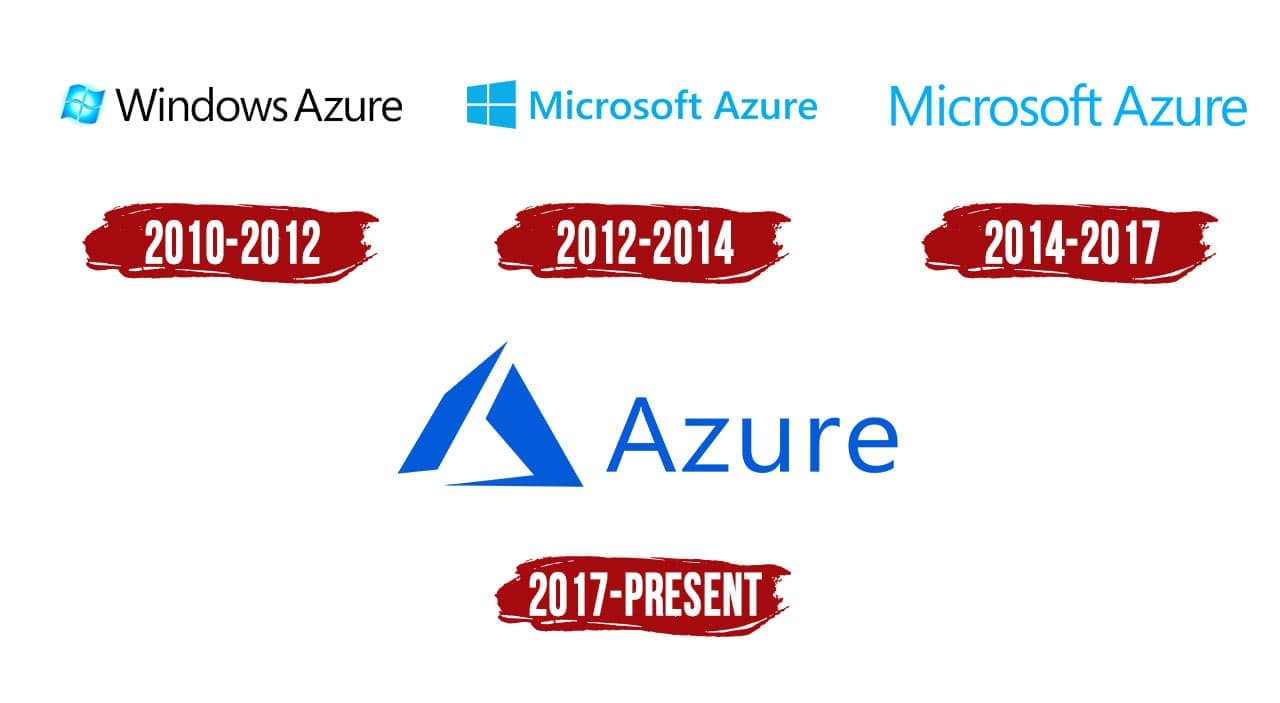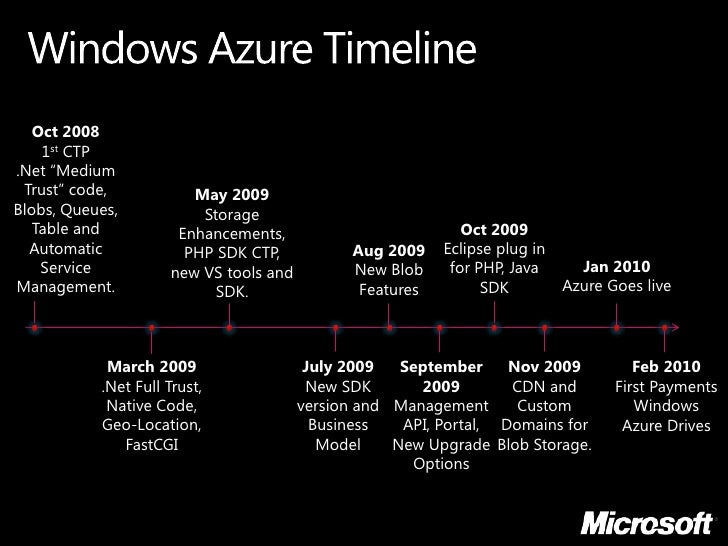The Emergence of Cloud Computing and Microsoft Azure
The history of Azure is deeply rooted in the emergence and growth of cloud computing, a paradigm shift in the way businesses and individuals utilize technology. Cloud computing enables on-demand access to shared resources, such as servers, storage, and applications, over the internet, allowing for greater scalability, flexibility, and cost savings compared to traditional on-premises infrastructure.
Microsoft Azure, initially released as Windows Azure in 2010, was Microsoft’s response to the rising demand for cloud services. The platform aimed to provide a robust and secure infrastructure for businesses and developers to build, deploy, and manage applications and services in the cloud. Azure’s initial offerings focused on Infrastructure-as-a-Service (IaaS) and Platform-as-a-Service (PaaS), allowing users to leverage virtual machines, databases, and application services without the need for managing physical hardware.
Key Milestones in Azure’s History
The history of Azure is marked by numerous significant events and updates that have shaped its evolution and growth. Here is a timeline of key milestones:
- 2010: Microsoft launches Windows Azure, offering virtual machines, SQL databases, and application services.
- 2012: Microsoft rebrands Windows Azure as Microsoft Azure, expanding its offerings to include Infrastructure-as-a-Service (IaaS) and Platform-as-a-Service (PaaS) solutions.
- 2014: Azure introduces Azure Active Directory, providing identity and access management services for cloud applications and resources.
- 2015: Microsoft announces the general availability of Azure Stack, enabling hybrid cloud scenarios for businesses.
- 2016: Azure launches Azure Functions, a serverless computing platform, and Azure Container Service, a container orchestration service.
- 2017: Microsoft acquires Cycle Computing, enhancing Azure’s high-performance computing capabilities.
- 2018: Azure introduces Azure Kubernetes Service (AKS), a managed Kubernetes platform, and Azure Machine Learning, a cloud-based machine learning service.
- 2019: Microsoft unveils Azure Arc, enabling hybrid and multi-cloud management, and Azure Synapse Analytics, a limitless analytics service.
- 2020: Azure announces the general availability of Azure Quantum, a cloud-based quantum computing service.
How Microsoft Azure Compares to Competitors
Azure competes in a dynamic and competitive cloud market, vying for market share against other major cloud providers such as Amazon Web Services (AWS) and Google Cloud Platform (GCP). To assess Azure’s position, it’s essential to consider factors such as features, pricing, and market share.
Features
Azure offers a wide range of services and features, including virtual machines, databases, serverless computing, and machine learning. Azure’s capabilities are continually expanding, with recent additions such as Azure Arc and Azure Synapse Analytics. While AWS remains the market leader in terms of services offered, Azure’s portfolio is robust and continues to grow, providing users with a compelling alternative.
Pricing
Azure’s pricing model is competitive, with various options for pay-as-you-go, reserved instances, and spot instances. Azure offers flexible pricing, enabling users to optimize costs based on their specific needs. While AWS generally has a lower entry price point, Azure’s pricing is often more cost-effective for enterprise-level workloads, particularly when considering long-term commitments.
Market Share
Azure has experienced steady growth in market share, currently holding the second-largest share behind AWS. According to recent reports, Azure’s market share is approximately 20%, while AWS holds around 33%. Google Cloud Platform lags behind, with a market share of around 10%. Azure’s growth trajectory indicates that it will continue to challenge AWS’s dominance in the cloud market.
In summary, Azure’s competitive position in the cloud market is strong, with a robust set of features, competitive pricing, and a growing market share. Businesses and individuals looking for a cloud platform should consider Azure as a viable alternative to AWS and GCP, particularly when considering factors such as enterprise-level capabilities and cost optimization.
The Impact of Azure on Modern Businesses
Microsoft Azure has significantly transformed the way businesses operate, offering a wide range of benefits that cater to the evolving needs of modern organizations. The platform’s scalability, flexibility, and cost savings have made it an attractive choice for businesses of all sizes and industries.
Scalability
Azure’s infrastructure enables businesses to scale their resources up or down as needed, ensuring optimal performance during peak usage periods and minimizing costs during periods of low demand. This scalability is particularly beneficial for businesses with fluctuating workloads, such as e-commerce companies during holiday seasons or startups experiencing rapid growth.
Flexibility
Azure supports a variety of operating systems, programming languages, frameworks, and tools, providing businesses with the flexibility to develop, deploy, and manage applications according to their unique requirements. This flexibility allows businesses to leverage existing investments in technology and expertise, reducing the need for costly and time-consuming retraining or replatforming efforts.
Cost Savings
Azure’s pay-as-you-go pricing model enables businesses to minimize upfront costs and only pay for the resources they consume. Additionally, Azure offers various cost optimization strategies, such as reserved instances, spot instances, and hybrid benefits, allowing businesses to further reduce their total cost of ownership.
In summary, Azure’s scalability, flexibility, and cost savings have revolutionized the way businesses operate, empowering them to innovate, grow, and adapt to changing market conditions. By embracing Azure, businesses can focus on delivering value to their customers, rather than managing and maintaining on-premises infrastructure.
Innovative Services and Solutions on Azure
Microsoft Azure has emerged as a leader in providing cutting-edge services and solutions that cater to a wide range of industries and use cases. The platform’s extensive portfolio includes offerings in areas such as artificial intelligence (AI), machine learning, and Internet of Things (IoT), empowering businesses to innovate and transform their operations.
Artificial Intelligence (AI)
Azure offers a comprehensive suite of AI services, including pre-built APIs for computer vision, natural language processing, and speech recognition. These services enable businesses to quickly and easily integrate AI capabilities into their applications, improving user experiences and driving operational efficiencies.
Machine Learning
Azure’s machine learning offerings enable businesses to build, train, and deploy custom machine learning models using a variety of tools and frameworks. Azure Machine Learning, Azure’s cloud-based machine learning service, simplifies the machine learning lifecycle, allowing data scientists and developers to focus on model development and iteration.
Internet of Things (IoT)
Azure’s IoT services provide businesses with the tools and infrastructure needed to securely connect, manage, and analyze IoT devices at scale. Azure IoT Hub, Azure’s managed IoT service, enables businesses to ingest and process massive volumes of IoT data, unlocking insights and driving business value.
In summary, Azure’s innovative services and solutions in AI, machine learning, and IoT have positioned the platform as a key driver of digital transformation for businesses across various industries. By leveraging these capabilities, businesses can unlock new opportunities for growth, innovation, and competitive advantage.
Azure’s Role in Digital Transformation
Microsoft Azure has emerged as a critical enabler of digital transformation for organizations across various industries, empowering them to innovate, streamline operations, and create new growth opportunities. By leveraging Azure’s extensive portfolio of services and solutions, businesses can accelerate their digital transformation journeys and stay ahead in today’s rapidly evolving market landscape.
Healthcare
Azure’s healthcare-specific offerings, such as Azure Health Data Services and Microsoft Cloud for Healthcare, enable healthcare organizations to securely store, process, and analyze sensitive health data, unlocking insights that can improve patient outcomes and reduce costs. Additionally, Azure’s integration with electronic health records (EHR) systems and medical devices enables seamless data exchange and interoperability, driving better care coordination and collaboration.
Finance
Azure’s financial services offerings, such as Azure for Financial Services and Microsoft Cloud for Financial Services, enable financial institutions to modernize their infrastructure, enhance security, and comply with regulatory requirements. Azure’s capabilities in areas such as risk management, fraud detection, and customer engagement empower financial institutions to deliver personalized, secure, and compliant services to their customers.
Retail
Azure’s retail-specific offerings, such as Azure for Retail and Microsoft Cloud for Retail, enable retailers to create seamless, omnichannel customer experiences, optimize supply chain operations, and leverage data-driven insights to drive growth and innovation. Azure’s capabilities in areas such as inventory management, demand forecasting, and personalized marketing empower retailers to deliver exceptional customer experiences and stay competitive in today’s challenging market conditions.
In summary, Azure’s role in digital transformation is significant, providing businesses across various industries with the tools and infrastructure needed to innovate, streamline operations, and create new growth opportunities. By embracing Azure, businesses can unlock the full potential of digital transformation and thrive in today’s rapidly evolving market landscape.
The Future of Azure: Trends and Predictions
As Microsoft Azure continues to evolve and mature, several emerging trends and predictions highlight the platform’s potential for growth and innovation. By staying abreast of these developments, businesses and individuals can better position themselves to leverage Azure’s capabilities and stay ahead in today’s rapidly evolving market landscape.
Serverless Computing
Serverless computing, which enables developers to build and run applications without managing servers, is expected to become increasingly popular on Azure. Azure Functions, Azure’s serverless compute service, allows developers to focus on writing code and delivering value, rather than managing infrastructure. As serverless computing continues to gain traction, businesses can expect to see more Azure services and tools that support this paradigm.
Multi-Cloud and Hybrid Cloud Strategies
As businesses increasingly adopt multi-cloud and hybrid cloud strategies, Azure is well-positioned to support these deployments. Azure Arc, a service that enables businesses to manage and govern their Azure, Azure Stack, and other Kubernetes environments from a single control plane, is expected to become a critical enabler of multi-cloud and hybrid cloud strategies. By embracing Azure Arc and similar services, businesses can unlock new opportunities for flexibility, scalability, and cost savings.
Artificial Intelligence (AI) and Machine Learning (ML)
Azure’s AI and ML capabilities are expected to become even more sophisticated and powerful in the coming years. With advancements in areas such as natural language processing, computer vision, and predictive analytics, businesses can expect to see more Azure services and tools that enable them to harness the power of AI and ML to drive innovation, streamline operations, and create new growth opportunities.
Security and Compliance
Security and compliance will continue to be top priorities for Azure, as the platform expands its capabilities in areas such as identity and access management, threat protection, and data privacy. With the increasing adoption of cloud computing and the growing importance of data security, Azure’s focus on security and compliance will become even more critical in the coming years.
In summary, Azure’s future looks bright, with emerging trends and predictions pointing to potential areas of growth and innovation. By staying abreast of these developments and embracing Azure’s capabilities, businesses and individuals can unlock new opportunities for flexibility, scalability, and cost savings, driving digital transformation and staying ahead in today’s rapidly evolving market landscape.
How to Get Started with Azure: A Step-by-Step Guide
Microsoft Azure offers a wide range of services and solutions for businesses and individuals looking to adopt cloud computing. To get started with Azure, consider the following step-by-step guide, which covers planning, implementation, and management aspects of Azure adoption.
Planning
1. Assess your organization’s needs and objectives: Begin by identifying the specific business challenges and opportunities you aim to address with Azure. Consider factors such as scalability, flexibility, and cost savings, and establish clear goals and metrics for success.
2. Evaluate Azure’s offerings: Familiarize yourself with Azure’s extensive portfolio of services and solutions, and identify the specific offerings that align with your organization’s needs and objectives.
3. Develop a migration strategy: Determine the best approach for migrating your existing workloads and applications to Azure, considering factors such as data privacy, security, and compliance.
Implementation
4. Create an Azure account: Sign up for an Azure account, and take advantage of any available free trials or promotional offers to test drive Azure’s capabilities.
5. Set up Azure subscriptions and resource groups: Organize your Azure resources into logical units called subscriptions and resource groups, enabling you to manage access, costs, and resources more effectively.
6. Deploy Azure services and solutions: Leverage Azure’s extensive documentation, tutorials, and support resources to deploy the specific services and solutions that align with your organization’s needs and objectives.
Management
7. Monitor and optimize Azure resources: Use Azure’s built-in monitoring, alerting, and analytics tools to track the performance, availability, and cost of your Azure resources, and make data-driven decisions to optimize resource utilization and minimize costs.
8. Implement security and compliance best practices: Ensure that your Azure resources are configured and managed in accordance with industry-standard security and compliance best practices, and take advantage of Azure’s built-in security features and tools to protect your data and applications.
In summary, adopting Azure requires careful planning, implementation, and management. By following this step-by-step guide, businesses and individuals can successfully leverage Azure’s capabilities to drive innovation, streamline operations, and create new growth opportunities.






